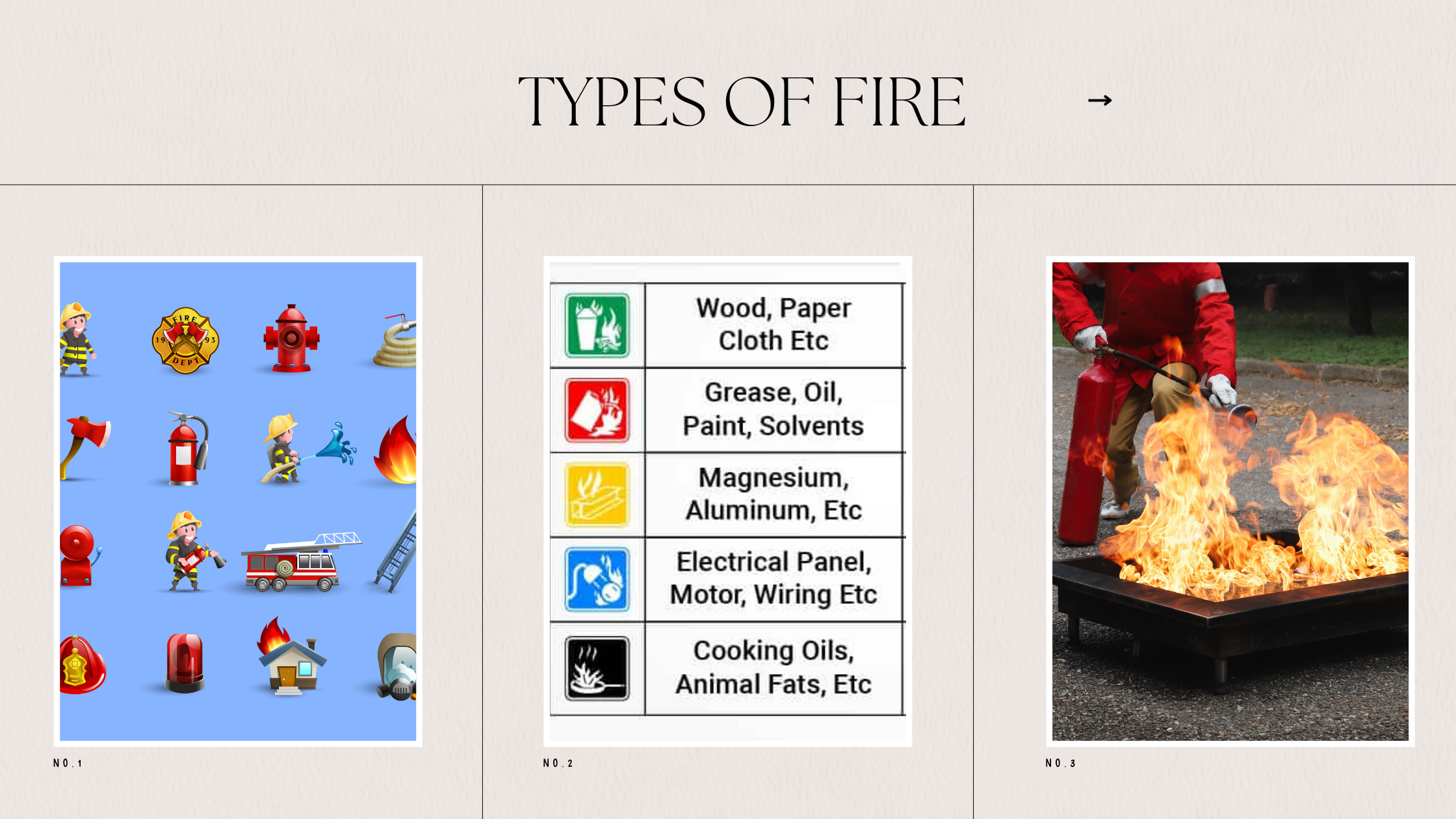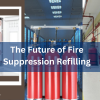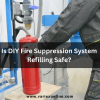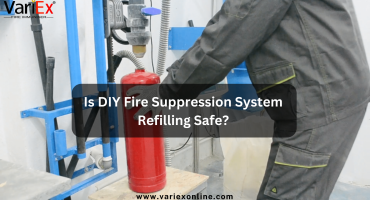![]()
Fire Immuniser
+91-7829629111
Email: info@variex.in
Varistor Technologies Pvt. Ltd.
Block-1, First Floor, Ardente Office One, Hoodi Circle, ITPL Main Road, Bengaluru, Karnataka 560048, IN
Types Of Fire
Types Of Fire
Fires can occur in various environments, and their nature can vary depending on the materials involved, the environment, and other factors. Understanding the different types of fires and knowing which type of fire extinguisher to use for each fire is crucial for effective fire safety and suppression. In this guide, we’ll explore the main types of fires, the classifications of fire extinguishers, and how to choose the right extinguisher for different situations.
Understanding the Different Types of Fires
Fires are categorized based on the type of material that is burning. These classifications help determine which type of fire extinguisher should be used to put out the fire effectively. The primary fire classifications are:
1. Class A Fires – Ordinary Combustibles
Class A fires involve ordinary combustible materials such as wood, paper, cloth, rubber, plastics, and other similar substances. These materials burn with a glowing, smoldering flame and are common in homes, offices, and industrial settings.
Examples of Class A fires:
- Paper or cardboard (e.g., burning files or documents)
- Wood (e.g., furniture, wooden pallets)
- Fabrics (e.g., curtains, clothing)
Fire Extinguisher to Use:
- Water Fire Extinguishers: Water extinguishers are effective for Class A fires because they cool the burning material below its ignition point.
- Foam Fire Extinguishers: Foam extinguishers work by forming a blanket over the fire to cut off oxygen and cool the material. They are effective on Class A fires as well as some Class B fires (flammable liquids).
- ABC Dry Chemical Extinguishers: These are versatile and effective for Class A, B, and C fires. The powder in the extinguisher interrupts the chemical reaction of the fire.
2. Class B Fires – Flammable Liquids and Gases
Class B fires involve flammable liquids, gases, and greases that burn quickly and intensely. These fires are common in kitchens, industrial settings, laboratories, and garages.
Examples of Class B fires:
- Gasoline, diesel fuel, and kerosene
- Oil, grease, and fats (e.g., cooking oils or motor oils)
- Paints and solvents
- Propane or butane gas
Fire Extinguisher to Use:
- Foam Fire Extinguishers: Foam extinguishers are highly effective for Class B fires as they create a barrier that suffocates the fire and prevents it from spreading.
- Carbon Dioxide (CO2) Extinguishers: CO2 extinguishers work well on Class B fires by displacing oxygen, which is necessary for combustion. CO2 is often used on electrical fires as well.
- ABC Dry Chemical Extinguishers: These extinguishers are also effective on Class B fires. The dry powder smothers the fire and interrupts the chemical reaction.
- Powder Fire Extinguishers: Specifically designed for Class B, powder extinguishers (often rated as BC or ABC) are effective in putting out flammable liquid fires by smothering the flame.
3. Class C Fires – Electrical Fires
Class C fires involve electrical equipment that is energized. These fires can be very dangerous because using water or foam can result in electric shock or cause more damage to the electrical system. Electrical fires can occur in homes, offices, and industrial settings with electrical equipment, circuits, and wiring.
Examples of Class C fires:
- Electrical appliances (e.g., toasters, computers, microwaves)
- Electrical panels, wiring, and circuit boards
- Power tools and industrial machinery
Fire Extinguisher to Use:
- Carbon Dioxide (CO2) Extinguishers: CO2 is one of the best choices for electrical fires, as it is non-conductive and effectively suffocates the fire by removing oxygen.
- ABC Dry Chemical Extinguishers: These are also suitable for Class C fires, as the powder is non-conductive and can smother the fire without causing electrical hazards.
- Clean Agent Fire Extinguishers: Clean agents like FM-200 or Novec 1230 are ideal for electrical fires, particularly in sensitive environments like server rooms, as they don’t leave residue and are safe for electronics.
4. Class D Fires – Combustible Metals
Class D fires involve combustible metals such as magnesium, titanium, potassium, sodium, and lithium. These metals burn at very high temperatures and require special extinguishing agents because traditional extinguishers (such as water or foam) can make the fire worse.
Examples of Class D fires:
- Magnesium alloy (used in aircraft and automotive components)
- Sodium or lithium-based compounds
- Potassium and potassium-based chemicals
Fire Extinguisher to Use:
- Dry Powder Fire Extinguishers: These extinguishers use specialized powders designed to suppress metal fires. The powder is often made from materials such as sodium chloride or graphite that react with the metal to extinguish the fire. Never use water or foam on a Class D fire, as it can cause violent reactions.
5. Class K Fires – Cooking Oils and Fats
Class K fires involve cooking oils and fats that are typically found in commercial kitchens, especially in deep fryers. These fires are unique because they burn at very high temperatures and can spread quickly if not handled properly. Cooking oil fires are particularly dangerous because they can escalate rapidly.
Examples of Class K fires:
- Vegetable oils, animal fats, or other cooking oils
- Grease fires in kitchens, especially commercial cooking areas
Fire Extinguisher to Use:
- Wet Chemical Fire Extinguishers: Wet chemical extinguishers are specifically designed to tackle Class K fires. They work by cooling and forming a soapy layer on top of the burning oil or fat, effectively smothering the fire and preventing it from re-igniting.
Fire Extinguisher Types and Their Uses
There are various types of fire extinguishers, each designed to handle specific classes of fires. Below is an overview of the most common types of fire extinguishers and their appropriate applications.
1. Water Fire Extinguishers
- Best for: Class A Fires (combustibles like wood, paper, textiles).
- How they work: Water extinguishers cool the fire by lowering the temperature of the burning material below its ignition point.
- Use: Ideal for ordinary combustible materials like wood, paper, and textiles. Do not use on electrical fires (Class C) or flammable liquids (Class B).
2. Foam Fire Extinguishers
- Best for: Class A and Class B Fires (combustibles and flammable liquids).
- How they work: Foam extinguishers suffocate the fire by creating a blanket of foam that cuts off oxygen and cools the burning material.
- Use: Ideal for use in environments with both combustible solids (Class A) and flammable liquids (Class B), such as kitchens, workshops, and laboratories.
3. ABC Dry Chemical Fire Extinguishers
- Best for: Class A, Class B, and Class C Fires (ordinary combustibles, flammable liquids, and electrical).
- How they work: The dry chemical powder interrupts the chemical reactions in the fire, effectively suppressing it.
- Use: Highly versatile, ABC extinguishers are commonly used in homes, offices, vehicles, and industrial settings where multiple fire hazards exist.
4. Carbon Dioxide (CO2) Fire Extinguishers
- Best for: Class B and Class C Fires (flammable liquids and electrical).
- How they work: CO2 extinguishers work by displacing oxygen, suffocating the fire and cooling it down. CO2 is non-conductive and does not leave residue.
- Use: Ideal for electrical fires and flammable liquid fires. They are often used in data centers, server rooms, kitchens, and manufacturing environments.
5. Powder Fire Extinguishers
- Best for: Class B, Class C, and Class D Fires (flammable liquids, electrical, and combustible metals).
- How they work: These extinguishers use a fine powder to smother the fire and break the chemical reaction fueling it.
- Use: Suitable for flammable liquid fires, electrical fires, and metal fires. Specific dry powder formulations are used for metal fires (Class D).
6. Wet Chemical Fire Extinguishers
- Best for: Class K Fires (cooking oils and fats).
- How they work: Wet chemical extinguishers release a solution that cools and smothers the fire. The agent also reacts with the burning oils to form a soap-like layer, preventing re-ignition.
- Use: Essential in commercial kitchens or any setting where deep fryers or cooking oils are used.
Conclusion
Understanding the different types of fires and which fire extinguishers to use in each case is essential for effective fire safety. Selecting the right type of extinguisher for the fire at hand can make the difference between quickly suppressing the fire and allowing it to spread uncontrollably. Always ensure that fire extinguishers are regularly maintained and that everyone in your environment knows which extinguisher to use in case of an emergency.
Remember: Always read the labels and instructions on fire extinguishers before use, and if you are unsure about the appropriate extinguisher for a specific fire, evacuate the area and call the fire department.
Final Say
At VariEx.in and VariexOnline.com, we specialize in supplying and installing top-quality fire fighting systems and equipment. From fire extinguishers to advanced suppression systems, we offer comprehensive solutions tailored to your needs. Our experienced team ensures precise installation and maintenance for optimal safety.
Trust VariEx for reliable fire protection. Contact us online or call 7829629111 to learn more.
We specialize in manufacturing, supplying, and distributing a comprehensive range of fire fighting equipment, including state-of-the-art fire extinguishers. Read our most searched blogs and find interesting information on topics such as how to use a fire extinguisher, how to calculate fire fighting water tank capacity, fire extinguisher refilling, obtaining a Fire NOC, understanding fire fighting systems, types of fire protection systems, the fire hydrant system, and the fire sprinkler system. These resources provide essential knowledge for ensuring safety and compliance with fire safety regulations. Additionally, you can explore guides on the maintenance of fire protection equipment, the latest advancements in fire safety technology, and best practices for fire risk assessment and management.
Our expertise extends to fire alarm systems, fire hydrant systems, and fire suppression systems, including fire sprinklers. Each product meets rigorous international standards for reliability and performance, ensuring effective fire safety products tailored to diverse applications and industries. Additionally, we are providing Fire Extinguisher Refilling and AMC services to ensure ongoing maintenance and operational readiness of fire safety equipment.










